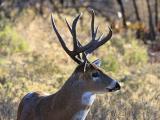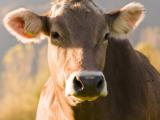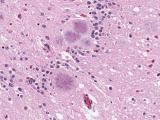Jun 13, 2005 (CIDRAP News) After one inconclusive and one negative test for bovine spongiform encephalopathy (BSE), a tissue sample from a downer cow has shown a positive result with a third test, authorities announced in a late-evening news conference Jun 10.
This round of testing involved three cows whose initial rapid tests were inconclusive, according to a news release from the US Animal and Plant Health Inspection Service (APHIS). A second test, called an immunohistochemistry (IHC) test was conducted, and all three animals tested negative for the progressively debilitating, fatal disease caused by a folded protein called a prion.
As a follow-up, the US Department of Agriculture (USDA) Office of the Inspector General (OIG) recommended the week of June 5 that all three samples be subjected to a third round of testing. This test, the Western blot, differs from the other two, the APHIS release explained. It is an internationally recognized confirmatory test for BSE, as is the IHC test.
Authorities sought this round of testing because one of the initial rapid tests had shown a positive reaction, APHIS noted. A sample from the same downer cow, which means a cow that couldn't walk, tested positive with the Western blot. The other two samples tested negative in the third round.
Because of the conflicting findings of the IHC and Western blot tests, further tests will now be conducted, authorities said.
A sample from the cow will be sent to a World Organization for Animal Health (OIE) recognized laboratory for BSE in Weybridge, England, said John Clifford, chief veterinary officer for APHIS during a telephone news conference late on Jun 10. In addition, USDA will be conducting further tests over the next several days.
Clifford and USDA Secretary Mike Johanns both emphasized that the conflicting test results are not an indictment of the US screening system for BSE.
"In the case of this animal, it was a nonambulatory downer animal and as such it was banned from the food supply," Clifford said. "It was taken to a facility that only handles downer animals unsuitable for human consumption and the carcass was incinerated." Samples from the cow were stored for further testing.
"After we receive additional tests on this animal, we will determine what further steps need to be taken and what changes if any are warranted in our surveillance program," he added.
The Western blot result was a "weak positive," Clifford said. "As a result of that and the unusualness of this case, it's going to require additional testing before we can confirm one way or another whether this is truly BSE or not."
"We have not confirmed a case of BSE in the US at this time," Clifford said. Indications are that the cow, described as an older beef cow, was born in the United States.
Johanns emphasized that this finding poses no risk to human health, adding that the findings should not affect trade discussions with other countries, because those discussions involve far younger cattle. Because BSE has a long incubation period, experts believe it is nearly impossible for cattle younger than 30 months to have infective levels of disease.
In all, some 375,000 cattle have been tested for BSE since the surveillance program began in June 2004, authorities said. The tests focus on downer cattle and cattle showing signs of neurological problems.
See also:
USDA teleconference transcript
BSE tests explained
http://ec.europa.eu/food/fs/bse/bse21_en.html















